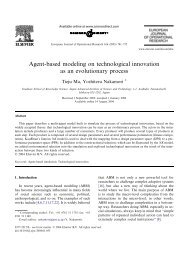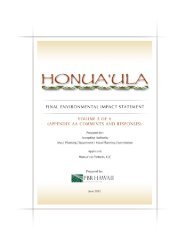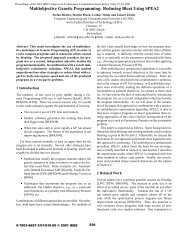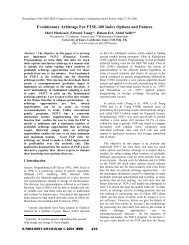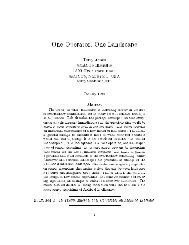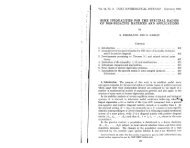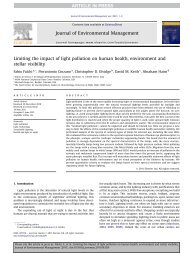draft eis comments and responses - Lee Altenberg
draft eis comments and responses - Lee Altenberg
draft eis comments and responses - Lee Altenberg
You also want an ePaper? Increase the reach of your titles
YUMPU automatically turns print PDFs into web optimized ePapers that Google loves.
May 31, 2012<br />
Mark Glick, Energy Administrator<br />
Hawaii State Energy Office<br />
P.O. Box 2359<br />
Honolulu, HI 96804<br />
SUBJECT: HONUA‘ULA DRAFT ENVIRONMENTAL IMPACT STATEMENT AND<br />
PROJECT DISTRICT PHASE II APPLICATION<br />
Dear Mr. Glick:<br />
We have received the letter dated June 2, 2010 from the Hawaii State Energy Office<br />
regarding the Honuaÿula Draft Environmental Impact Statement (EIS) <strong>and</strong> the Project<br />
District Phase II application. As the planning consultant for the l<strong>and</strong>owner, Honua‘ula<br />
Partners, LLC, we are responding to <strong>comments</strong>.<br />
1. State energy conservation goals.<br />
Honua‘ula Partners, LLC is aware of, <strong>and</strong> recognizes, the State’s energy conservation,<br />
goals, policies, <strong>and</strong> st<strong>and</strong>ards. As explained in the Draft EIS, <strong>and</strong> as acknowledged by the<br />
Hawaii State Energy Office, Honua‘ula Partners, LLC is committed to reducing energy<br />
consumption. Energy-saving concepts <strong>and</strong> devices will be encouraged in the design of<br />
Honua‘ula <strong>and</strong> energy systems for all residential units will meet all applicable ENERGY<br />
STAR requirements established by the EPA in effect at the time of construction. In addition,<br />
design st<strong>and</strong>ards will specify low-impact lighting <strong>and</strong> will encourage energy-efficient<br />
building design <strong>and</strong> site development practices.<br />
Honua‘ula Partners, LLC’s electrical engineer will continue to coordinate with MECO<br />
regarding the need for exp<strong>and</strong>ing MECO’s Wailea Substation <strong>and</strong> Honua‘ula Partners, LLC<br />
will continue to include an area for the expansion of the substation on Honua‘ula plans.<br />
We are not clear regarding the statement that: “…the selected method of wastewater<br />
treatment will significantly impact the project’s electricity <strong>and</strong>/or fuel consumption.” As<br />
explained in the Draft EIS, Honua‘ula Partners, LLC will either: 1) transport wastewater<br />
approximately one mile south to the Mäkena Resort Wastewater Reclamation Facility<br />
(WWRF) for treatment; or 2) develop, maintain, <strong>and</strong> operate a private on-site WWRF. After<br />
treatment, the R-1 recycled water will be used within Honua‘ula for golf course irrigation.<br />
Proper treatment <strong>and</strong> disposal of wastewater is a critical requirement of any project, <strong>and</strong><br />
Honua’ula’s zoning conditions specifically require that such treatment <strong>and</strong> disposal be<br />
done at a private wastewater treatment facility. Even if use of a public facility were an<br />
option, this would require transporting wastewater to the Kïhei WWRF, located<br />
approximately four miles northwest of Honua‘ula, <strong>and</strong> then transporting the R-1 recycled<br />
water back to Honua‘ula. While energy consumption for treatment at any of the treatment<br />
sites is assumed to be roughly the same, the energy required to transport sewage to the<br />
Kïhei WWRF <strong>and</strong> then convey the R-1 recycled water back to Honua‘ula can be assumed<br />
to be much greater than to <strong>and</strong> from the closer Mäkena Resort WWRF or an on-site<br />
WWRF. Therefore, Honua’ula Partners, LLC is confident that its selected method of<br />
Mark Glick<br />
SUBJECT: HONUAÿULA DRAFT ENVIRONMENTAL IMPACT STATEMENT AND PROJECT<br />
DISTRICT PHASE II APPLICATION<br />
May 31, 2012<br />
Page 2 of 4<br />
wastewater treatment is the most effective means of treating <strong>and</strong> disposing wastewater from an<br />
energy perspective.<br />
2. Solar Water Heater System Required.<br />
We are aware that, effective January 1, 2010, no building permit shall be issued for a new singlefamily<br />
dwelling that does not include a solar water heating system that meets st<strong>and</strong>ards established<br />
by the Hawaii Public Utilities Commission, unless the DBEDT Director approves a variance (HRS<br />
§196-6.5). As discussed in the Draft EIS, all Honua‘ula residential units will be equipped with a<br />
primary hot water system at least as energy efficient as a conventional solar panel hot water<br />
system, sized to meet at least 80 percent of the hot water dem<strong>and</strong> for the unit.<br />
3. Leadership in Energy <strong>and</strong> Environmental Design (“LEED”) certification.<br />
We acknowledge the recommendation to implement Leadership in Energy <strong>and</strong> Environmental<br />
Design (LEED) certification to complement the ENERGY STAR Program. The Draft EIS contains<br />
many commitments to conserve resources, such as provisions for water <strong>and</strong> energy conservation,<br />
green <strong>and</strong> solid waste recycling, transportation dem<strong>and</strong> management, <strong>and</strong> stewardship of<br />
resources. Restricting these commitments <strong>and</strong> other innovations that may be provided over the 13-<br />
year build out period under a single certification system that is currently in favor does not seem<br />
wise or warranted. While LEED is a popular certification system at the moment, it is not the only<br />
green building verification system. For example, the Green Globes system is gaining recognition<br />
<strong>and</strong> acceptance as a system more assessable than LEED <strong>and</strong> more advanced in the area of lifecycle<br />
assessment, which measures the environmental impact of the production <strong>and</strong> acquisition of<br />
products used for buildings. In another example, the Passive House St<strong>and</strong>ard seeks to monitor the<br />
on-going energy efficiency of buildings after they are built <strong>and</strong> in operation. Other evolving<br />
systems seek to promulgate region specific st<strong>and</strong>ards, so that appropriate technology is encouraged<br />
in suitable regions.<br />
The entire green building movement is a dynamic <strong>and</strong> fluid field that continues to rapidly evolve,<br />
<strong>and</strong> better st<strong>and</strong>ards may be created in the future. Some have even argued that m<strong>and</strong>ating LEED<br />
hinders development of other st<strong>and</strong>ards that may prove more appropriate, as the blanket adoption<br />
of LEED as the sustainable st<strong>and</strong>ard may come at the expense of other emerging systems. Others<br />
reason that when a st<strong>and</strong>ard is m<strong>and</strong>ated it sets a ceiling as to the level of compliance, so the<br />
st<strong>and</strong>ard becomes the new minimum at the expense of new innovations that may not be<br />
implemented because they exceed the minimum. A dynamic process enables st<strong>and</strong>ards to<br />
continually improve by responding to the needs of consumers <strong>and</strong> builders, adjusting to new<br />
technology <strong>and</strong> experience, <strong>and</strong> using competition to promote a variety of approaches.<br />
The LEED program was originally created <strong>and</strong> introduced by the U.S. Green Building Council as a<br />
voluntary program to empower individuals to assess st<strong>and</strong>ards <strong>and</strong> then choose when, how <strong>and</strong><br />
whether to employ them. The idea was that incentives <strong>and</strong> competition would support market<br />
transformation of the building industry <strong>and</strong> spur architects, builders, <strong>and</strong> product manufacturers to<br />
create green products, buildings, <strong>and</strong> communities. LEED was never developed as a building or<br />
“sustainability” code. According to the U.S. Green Building Council LEED is “voluntary,<br />
consensus-based, <strong>and</strong> market-driven” <strong>and</strong> further, LEED seeks a balance between requiring the<br />
best existing practices <strong>and</strong> the voluntary incorporation of emerging concepts.



